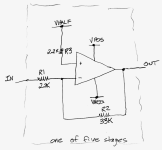The standard measurement procedure is to connect 5 of them as a ring oscillator and then measure the oscillation frequency, propagation delay, rise time, fall time, and power consumption. From those measured quantities you can derive all the performance specifications you like.
Attachments
My mistake, 353 is similar but not the same family. I mixed it for LF355.If you need speed you should consider LF357N which is fast variant of it. LF356N is also faster.
Data sheet
https://www.ti.com/lit/gpn/lf353-n
Scroll down to pulse responce, It also depends on load.
https://www.ti.com/lit/gpn/lf353-n
Scroll down to pulse responce, It also depends on load.
To be pedantic nothing is being turned on and off here. We are amplifying a square wave.
If the intention is to drive something as a logic signal a comparator, not an opamp, is the best way.
If just amplifying a signal that's a 5kHz square wave most opamps have a healthy gain bandwidth in the tens of MHz so will handle this. The clear exception are ultra-low-power opamps and the LM358.
If the intention is to drive something as a logic signal a comparator, not an opamp, is the best way.
If just amplifying a signal that's a 5kHz square wave most opamps have a healthy gain bandwidth in the tens of MHz so will handle this. The clear exception are ultra-low-power opamps and the LM358.
Your biggest concern is probably the input capacitance of the scope then. If you want good fidelity on the pulse you may also want to use the 50 Ω input impedance setting on the scope (or a 50 Ω terminator if your scope doesn't have built-in 50 Ω termination) which will render that LF353 pretty useless. Then again, for 5 kHz (so maybe 50-100 kHz bandwidth) you could choose not to worry about proper termination or ... <concept> ... use a scope probe.My load is very little
It only feed a Oscilloscope
Tom
This what looking at .Your biggest concern is probably the input capacitance of the scope then. If you want good fidelity on the pulse you may also want to use the 50 Ω input impedance setting on the scope (or a 50 Ω terminator if your scope doesn't have built-in 50 Ω termination) which will render that LF353 pretty useless. Then again, for 5 kHz (so maybe 50-100 kHz bandwidth) you could choose not to worry about proper termination or ... <concept> ... use a scope probe.
Tom
It is good 100MHZ.
Attachments
Last edited:
- Home
- Design & Build
- Electronic Design
- How fast can a LF353N be turn off and on
